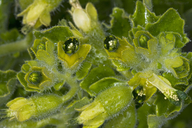notes Note the flower at lower right has been longitudinally split open to reveal the many (very short-stalked) anthers distributed densely over the upper half of the corolla's interior. This is completely different than the attachment of anthers in the congener Eucnide urens, as is the tubular corolla morphology here.
_______________________________________________________ This remarkable plant is very rare in (Alta) California, though less so in Baja California and Sonora, Mexico. In floral structure, it is radically different from its single (Alta) California congener, E. urens...so much so that I found it hard to fathom how they could both be circumscribed in the same genus! But a careful reading of the very interesting 1967 paper ''Floral Biology and Systematics of Eucnide'' by Thompson & Ernst clarified the situation.
This plant is only known in (Alta) CA from three locations in southern San Diego Co. and in most years may not even germinate here, or at least goes unseen...for more details on this see Tom Chester's Eucnide rupestris web page. I saw these plants on an excursion with Tom, who had learned of them from a sighting on January 13, 2018 by Fred Melgert and Carla Hoegen (see these CalPhotos posts). The plants were in full flower on 1/13/18...and on 1/17/18 when Tom first visited them.
I didn't make it to southern California until March 18 (59 days later), and since both the Jepson eFlora key and the FNA description indicate this is an annual, I figured the plants would be shriveled and dead when we planned to visited the site. However, to my amazement (and delight!), the plant shown here (which had been in full flower on Jan 18) was still in very robust flower! Of the other individuals we saw, one was still mostly green and in fruit, and two more were in fruit but very much desiccated and browning. It should be noted that in this very dry year hardly any other plants in the vicinity were flowering, and virtually no annuals had germinated. Tom believes a monsoonal rain from the preceding September was responsible for the Eucnide germinating and flowering this year...and that the infrequency of monsoonal events in the area explains why E. rupestris is so rarely present in most years. Monsoonal rains are more common in its Baja California and Sonora range, where Tom believes it's typically a short-lived perennial...vs. behaving like a facultative annual in the Anza-Borrego area (cf. 1st paragraph of Thompson & Ernst here).
Tom, James Dillane, and I were very curious about possible pollinators. The aforementioned paper of Thompson & Ernst stated this species is the most autogamous of all Eucnide species, seeming to suggest it may be entirely self-pollinated. They saw no pollinator visits during a 3-hour study at mid-day. However, James noted Thomson & Ernst had indicated that the day of their observation was overcast (see 2nd paragraph here). And a single 3-hour observation in the middle of an overcast day does not seem sufficient to rule out insect pollinators with much certainty. It should be noted that Thompson & Ernst also based their hypothesis of autogamy on the small, inconspicuous flowers (having tight tubular corollas with small apical opening)...and on the morphological uniformity of E. rupestris throughout its comparatively large range. But we still held out hope of the possibility of observing (and ideally photo-documenting) insect visitors to the flowers.
However...after studying the site and my photos...I am now also beginning to think the likelihood of encountering insect pollinators is very low. This is partly because the entire plant (including the corolla) is so densely well-armed with spiny trichomes and both stalked and sessile glands which would seem to make it very difficult for a pollinator to land anywhere near the flower to access nectar or pollen. So any candidate pollinators (e.g. bee flies, bees, or lepidoptera) would likely need to hover...and also have very long mouthparts...in order to reach any nectar at the base of the tubular corolla. That seems to further support Thompson & Ernst's hypothesis of likely autogamy for this species.
